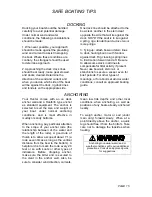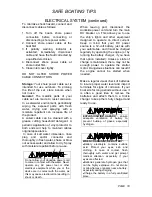
SAFE BOATING TIPS
PAGE
17
STARTING YOUR DIESEL ENGINE
1. Visually check engine compartment to
see that the throttle linkage, shifting
controls, electrical connections and fuel
lines are properly secured.
2.
Before each start
check oil in engine
and transmission.
3. Insure that the engine shut-off cable is
properly secured and operating.
4. Place the shift lever in the neutral
position. Pull out the button beside the
shift lever to disengage the shift. On
single lever controls, lift the collar under
the shift lever knob and move the lever
forward to advance the throttle for
neutral warm-up.
5. Insert the starter key and turn to the
“
on
”
position.
6. Press the starter button and hold until
engine starts, then release. The buzzer
and/or light should then go off.
Press
the starter button no longer than 5
seconds continuously.
7. Allow cold engine to warm up a
minimum of five minutes.
8. When warm-up is completed, return the
hand lever to neutral position, and push
the button back to re-engage the shift.
The shift is ready for shift and throttle
operation.
9. Check that the lube oil pressure
warning light and the charge lamp go
off. If any of the warning lamps do not
go off above 1,000 rpm, the engine is
malfunctioning and should be stopped
immediately. Consult your nearest
engine dealer.
NOTE: The H386 and below are equipped
with an
“
engine stop
”
pull lever. When
pulled all the way out, this will stop the
engine at any time.
Follow
engine
manufacturer
’
s
recommendations for types of fuel and
oil. Use of improper products can
damage the engine and void the
warranty.
MOTORING YOUR DIESEL ENGINE
Before departure, remember to unplug the
shore power. When the engine is warm,
but prior to releasing the dock lines, move
the shift lever to forward and to reverse to
insure that it is working properly. To
increase RPMs, push throttle lever
forward and pull back to decrease RPMs.
IMPORTANT: When sailing, it is best to
start the engine before the sails are
lowered. This way, it is possible to
maneuver if the engine should not start.
Your rigging will conduct electricity.
Always check for overhead high tension
wires before proceeding. Once clear,
you may increase your speed in a
reasonable
and
safe
manner
as
desired.
ELECTRICAL SYSTEM
Your Hunter is fitted with an electrical
system designed for both AC and DC.
While in port, you can operate any tool,
appliance or other device designed to
function on regular house current simply
by plugging your dockside power cord into
a convenient outlet on shore and turning
your AC main breaker on.
ELECTROCUTION HAZARD: If polarity
is reversed, DO NOT use the shore
power source. Immediately turn off the
power source and disconnect the shore
power cord. Reversed polarity is a
dangerous
and
potentially
lethal
condition that may cause shock,
electrocution, or death.
Summary of Contents for sailing yacht
Page 28: ......
Page 39: ......
Page 40: ......
Page 41: ......
Page 43: ......
Page 46: ......
Page 47: ......
Page 48: ......
Page 49: ......
Page 50: ......
Page 51: ......
Page 52: ......
Page 53: ......
Page 54: ......
Page 55: ......
Page 56: ......
Page 57: ......
Page 58: ......
Page 59: ......
Page 62: ......
Page 63: ......
Page 64: ......
Page 65: ......
Page 67: ......
Page 68: ......
Page 69: ......
Page 70: ......
Page 71: ......
Page 74: ......
Page 77: ......
Page 78: ......
Page 79: ......
Page 80: ......
Page 81: ......
Page 82: ......
Page 83: ......
Page 84: ......
Page 85: ......
Page 86: ......
Page 87: ......
Page 88: ......
Page 89: ......
Page 90: ......
Page 91: ......
Page 92: ......
Page 93: ......
Page 94: ......
Page 95: ......
Page 96: ......
Page 97: ......
Page 98: ......
Page 99: ......
Page 100: ......
Page 101: ......
Page 102: ......
Page 103: ......
Page 104: ......
Page 105: ......
Page 106: ......
Page 107: ......
Page 108: ......
Page 109: ......
Page 110: ......
Page 111: ......
Page 112: ......
Page 113: ......
Page 117: ......
Page 118: ......
Page 119: ......
Page 122: ......
Page 123: ......
Page 124: ......
Page 129: ......
Page 130: ......
Page 131: ......
Page 132: ......
Page 133: ......
Page 134: ......
Page 135: ......
Page 136: ......
Page 137: ......
Page 138: ......
Page 139: ......
Page 140: ......
Page 141: ......
Page 142: ......
Page 143: ......
Page 144: ......
Page 145: ......
Page 146: ......
Page 147: ......
Page 148: ......
Page 149: ......
Page 150: ......
Page 151: ......
Page 152: ......
Page 153: ......
Page 154: ......
Page 155: ......
Page 156: ......
Page 157: ......
Page 158: ......
Page 159: ......
Page 160: ......
Page 161: ......
Page 162: ......
Page 163: ......
Page 164: ......
Page 165: ......
Page 166: ......
Page 167: ......
Page 168: ......
Page 169: ......
Page 170: ......
Page 171: ......
Page 174: ......
Page 175: ......
Page 176: ......
Page 177: ......
Page 178: ......
Page 179: ......
Page 180: ......
















































